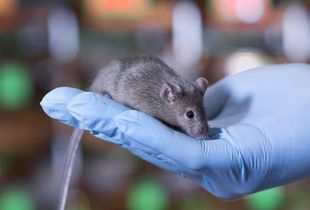There are no known Mendelian diseases caused by variants in RABGAP1 yet. Clinicians and Scientists either caring for patients with rare homozygous genetic variances in the gene RABGAP1 or working on the KO mouse model teamed up to find the link from the gene function to the patient’s symptoms.
The study led by the Hospital of Sick Children in Canada and supported by colleagues from University of Groningen, Netherland, Australia, and the German Mouse Clinic, was recently published in “Genetics in Medicine”.
RABGAP1 is a GTPase-activating protein that has been found to interact with many different RAB GTPase proteins. The protein is implicated in a variety of cellular and molecular processes, including mitosis, cell migration, vesicular trafficking, and mTOR signaling. Through GeneMatcher, 5 patients from 3 unrelated families with homozygous variants in the RABGAP1 gene were found on exome sequencing after clinical evaluation. The patients’ ages ranged from 2 to 13 years. All affected individuals with biallelic variants in RABGAP1 presented with severe global developmental delay/intellectual disability. All individuals except one patient presented significant microcephaly (on average, 3-4 SD below mean). In addition, the patients showed congenital anomalies like bilateral sensorineural hearing loss, and seizures, as well as overlapping dysmorphic features. Neuroimaging revealed common features, including delayed myelination, white matter volume loss, ventriculomegaly, and thinning of the corpus callosum.
To find additional evidence for the causal involvement of the LOF gene variation, a Rabgap1 KO mouse model was analyzed. The KO mice showed similar neurologic features to those of the patient cohort such as microcephaly, thinning of the corpus callosum, and ventriculomegaly. X-ray images of mice were analyzed and microcephaly, reflected in significantly reduced skull width, was diagnosed in mutant animals. Histological analysis revealed thinning of the corpus callosum in Rabgap1 KO mice. Further, the mutant mice with deformity of the skull showed severe dilation of the third and lateral ventricles and atrophy of the cortex. RABGAP1 function was further studied in Lymphoblastoid cells lines derived from an affected patient and her parents. Loss of RABGAP1 function induced downregulation of mTOR signaling, abnormal localization of early endosomes and lysosomes and decreased levels of both phospho-S6 and phospho-AKT.
This study presented new evidence that biallelic variants in RABGAP1 lead to abnormal neurodevelopment through a LOF mechanism, which may be mediated by downregulation of the mTORC1 signaling pathway. The specific neurodevelopmental features were shared by affected individuals from different families; and importantly supported by the similar phenotype seen in the Rabgap1 KO mice. The term RABGAP1- related disorder is suggested to describe this condition associated with neurodevelopmental and multiple congenital anomalies caused by pathogenic RABGAP1 variants.
Biallelic loss-of-function variants in RABGAP1 cause a novel neurodevelopmental syndrome. Oh RY, Deshwar AR, Marwaha A, Sabha N, Tropak M, Hou H, Yuki KE, Wilson MD, Rump P, Lunsing R, Elserafy N, Chung CWT, Hewson S, Klein-Rodewald T, Calzada-Wack J, Moreno AS, Kraiger M, Marschall S, Fuchs H, Gailus-Durner V, Hrabe de Angelis M, Dowling J, Schulze A. Genet Med. 2022 Sep 8:S1098-3600(22)00877-2. doi: 10.1016/j.gim.2022.07.024. Epub ahead of print. PMID: 36083289.


